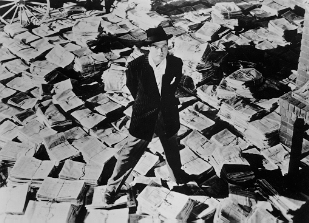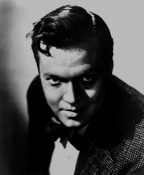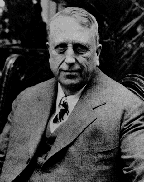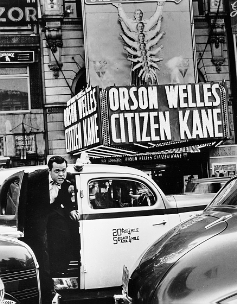The Battle Over Citizen Kane
 November 21, 1997 (Friday) at 7:00 p.m. (NOTE TIME CHANGE)
November 21, 1997 (Friday) at 7:00 p.m. (NOTE TIME CHANGE)
(Free and Open to the Public)
b/w & color, 35 mm)
Directed by Thomas Lennon and Michael Epstein
Combining social history, movie lore, and personality assessments, THE BATTLE OVER CITIZEN KANE documents the clash between Orson Welles and press baron William Randolph Hearst over the making of CITIZEN KANE. The documentary won a Peabody Award for WGBH-TV, Boston's public television station.
Thomas Lennon, documentary film maker and the producer/writer of THE BATTLE OVER CITIZEN KANE will provide commentary and answer questions immediately following the screening. Lennon has produced numerous PBS documentaries include BATTLE OF THE BULGE for "The American Experience" series and TABLOID TRUTH, THE CHOICE '92, and SEVEN DAYS IN BENSONHURST for PBS's "Frontline" series. Lennon Documentary Group is producing a six-hour history of the Irish in American projected to air on PBS in 1997.
 Orson Welles was famous at age 24--long before he arrived in Hollywood. A theatrical prodigy who took to the new medium of radio as no one ever had, Welles was offered a very sweet movie contract by RKO and set out to make a film about the most powerful man in America--newspaper mogul William Randolph Hearst. But Welles's huge ego and his youth would blind him to the extent of Hearst's power and reach; he tragically underestimated Hearst's ability to counterattack. THE AMERICAN EXPERIENCE: The Battle over Citizen Kane, aired on PBS, tells the story of these two flawed and fascinating men, and the tragic battle that ultimately destroyed them both.
Orson Welles was famous at age 24--long before he arrived in Hollywood. A theatrical prodigy who took to the new medium of radio as no one ever had, Welles was offered a very sweet movie contract by RKO and set out to make a film about the most powerful man in America--newspaper mogul William Randolph Hearst. But Welles's huge ego and his youth would blind him to the extent of Hearst's power and reach; he tragically underestimated Hearst's ability to counterattack. THE AMERICAN EXPERIENCE: The Battle over Citizen Kane, aired on PBS, tells the story of these two flawed and fascinating men, and the tragic battle that ultimately destroyed them both.
 Newspaper mogul William Randolph Hearst was the most powerful man in America when "boy genius" Orson Welles took aim at him by basing CITIZEN KANE on Hearst's life--it wasn't a flattering portrayal. Incensed over the thinly veiled portrait of himself in CITIZEN KANE, Hearst launched a battle to destroy both the film and the filmmaker. Hearst's campaign to discredit Welles was ruthless, skillful, and much aided by Welles himself, who never bothered to hide his contempt for Hollywood. THE AMERICAN EXPERIENCE: The Battle over Citizen Kane, aired on PBS, is a story of the collision of two quintessential American characters, strikingly similar in many ways.
Newspaper mogul William Randolph Hearst was the most powerful man in America when "boy genius" Orson Welles took aim at him by basing CITIZEN KANE on Hearst's life--it wasn't a flattering portrayal. Incensed over the thinly veiled portrait of himself in CITIZEN KANE, Hearst launched a battle to destroy both the film and the filmmaker. Hearst's campaign to discredit Welles was ruthless, skillful, and much aided by Welles himself, who never bothered to hide his contempt for Hollywood. THE AMERICAN EXPERIENCE: The Battle over Citizen Kane, aired on PBS, is a story of the collision of two quintessential American characters, strikingly similar in many ways.

The Battle over Citizen Kane
The Battle over Citizen Kane is about two colossal Americans on a collision course. It is about the sparks given off by giant egos holding forth at center stage in American life. It is also about the often blurred, confusing boundaries between reality and illusion in American life. In his time, each of our protagonists was the acclaimed master of his medium. Both vaulted to the pinnacle as boy wonders, each in turn catching the wave of revolutionary changes in mass communication and mass entertainment.
Beginning in the late nineteenth century, William Randolph Hearst transformed newspaper publishing. A man who adored sensation, he knew the power of lurid detail, of photographs, drawings, and, if need be, manipulation. When his artist-correspondent, Frederic Remington, arrived in Cuba in 1897 to cover an anticipated Spanish-American War, only to find there was no war, Remington cabled Hearst for permission to return. Hearst reportedly cabled back, "You provide the pictures and I'll provide the war." Then, nearly fifty years later, came the theatrical prodigy Orson Welles, who took to the new medium of radio as no one ever had and in no time was off to Hollywood to make a movie to carry him higher still, a movie inspired by the career of William Randolph Hearst. Welles would direct and play the leading role. He would become Hearst.
The movie was Citizen Kane, the Orson Welles masterpiece that many present-day directors and critics consider the greatest film ever made. But our story is about what happened when the real-life Welles and the real-life Hearst collided head on.
![]()
[an error occurred while processing this directive]